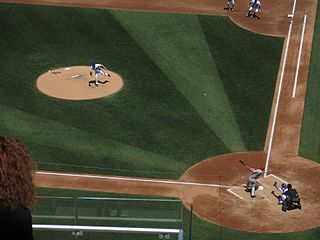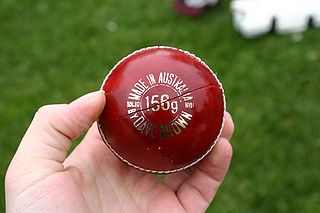
Baseball is a bat-and-ball sport played between two teams of nine players each, taking turns batting and fielding. The game occurs over the course of several plays, with each play generally beginning when a player on the fielding team, called the pitcher, throws a ball that a player on the batting team, called the batter, tries to hit with a bat. The objective of the offensive team is to hit the ball into the field of play, away from the other team's players, allowing its players to run the bases, having them advance counter-clockwise around four bases to score what are called "runs". The objective of the defensive team is to prevent batters from becoming runners, and to prevent runners' advance around the bases. A run is scored when a runner legally advances around the bases in order and touches home plate.

Softball is a popular variation of baseball, the difference being that it is played with a larger ball on a smaller field and with only underhand pitches permitted. Softball is played competitively at club levels, the college level, and the professional level. The game was first created in 1887 in Chicago by George Hancock.

Backyard cricket, also known as bat ball, street cricket, beach cricket, corridor cricket, garden cricket, gully cricket and box cricket, is an informal variant of cricket. It is typically played in various non-traditional venues such as gardens, backyards, streets, parks, carparks, beaches, and any area not specifically designed for the sport. Backyard cricket is commonly played in India, Bangladesh, Pakistan, and Sri Lanka.

This is a general glossary of the terminology used in the sport of cricket. Where words in a sentence are also defined elsewhere in this article, they appear in italics. Certain aspects of cricket terminology are explained in more detail in cricket statistics and the naming of fielding positions is explained at fielding (cricket).

In cricket, an over consists of six legal deliveries bowled from one end of a cricket pitch to the player batting at the other end, almost always by a single bowler.

In cricket, a no-ball is a type of illegal delivery to a batter. It is also a type of extra, being the run awarded to the batting team as a consequence of the illegal delivery. For most cricket games, especially amateur, the definition of all forms of no-ball is from the MCC Laws of Cricket.
A cricket bat is a specialised piece of equipment used by batters in the sport of cricket to hit the ball, typically consisting of a cane handle attached to a flat-fronted willow-wood blade. It may also be used by a batter who is making batter's ground to avoid a run out, by holding the bat and touching the ground with it. The length of the bat may be no more than 38 inches and the width no more than 4.25 inches. Its use is first mentioned in 1624. Since 1979, a law change has dictated that cricket bats can only be made from wood.

A cricket ball is a hard, solid ball used to play cricket. A cricket ball consists of a cork core wound with string then a leather cover stitched on, and manufacture is regulated by cricket law at first-class level. The trajectory of a cricket ball when bowled, through movement in the air, and off the ground, is influenced by the action of the bowler and the condition of the ball and the pitch, while working on the cricket ball to obtain optimal condition is a key role of the fielding side. The principal method through which the batter scores runs is by hitting the ball, with the bat, into a position where it would be safe to take a run, or by directing the ball through or over the boundary. Cricket balls are harder and heavier than baseballs.

Indoor cricket is a variant of and shares many basic concepts with cricket. The game is most often played between two teams each consisting of six or eight players.
Short form cricket is a collective term for several modified forms of the sport of cricket, with playing times significantly shorter than more traditional forms of the game.
Club cricket is a mainly amateur, but still formal form of the sport of cricket, usually involving teams playing in competitions at weekends or in the evening. There is a great deal of variation in game format although the Laws of Cricket are observed. The main nations that club cricket is played in include Pakistan, England, Australia, South Africa, Sri Lanka, West Indies, New Zealand, Bangladesh, Nepal, Zimbabwe, Kenya, Ireland, Wales, Scotland, Netherlands, Hong Kong and in some of the major cities in India. Club cricket is also now played in the United States and Canada, as both countries have large communities of immigrants from mainstream cricket-playing regions such as the Caribbean, Europe, Asia, Africa and Australasia.
Cricket is a multi-faceted sport with different formats, depending on the standard of play, the desired level of formality, and the time available. One of the main differences is between matches limited by time in which the teams have two innings apiece, and those limited by number of overs in which they have a single innings each. The former, known as first-class cricket if played at the senior level, has a scheduled duration of three to five days ; the latter, known as limited overs cricket because each team bowls a limit of typically 50 overs, has a planned duration of one day only. A separate form of limited overs is Twenty20, originally designed so that the whole game could be played in a single evening, in which each team has an innings limited to twenty overs.

A baseball is the ball used in the sport of baseball. It consists of a rubber or cork center wrapped in yarn and covered with white natural horsehide or cowhide, or a synthetic composite leather. A regulation baseball is 9 to 9.25 inches in circumference i.e. 2.86 to 2.94 inches in diameter, with a weight of 5 to 5.25 ounces.
Baseball and cricket are the best-known members of a family of related bat-and-ball games. Both have fields that are 400 feet (120 m) or more in diameter between their furthest endpoints, offensive players who can hit a thrown/"bowled" ball out of the field and run between safe areas to score runs (points) at the risk of being gotten out, and have a major game format lasting about 3 hours.
Law 41 of the Laws of Cricket covers unfair play. This law has developed and expanded over time as various incidents of real life unfair play have been legislated against.
Trobriand Cricket: An Ingenious Response to Colonialism is an anthropological Documentary film about the people of the Trobriand Islands and their unique innovations to the game of cricket, filmed in 1973–74. The film was made by Gary Kildea, under the direction of anthropologist Jerry Leach. It was shot in three weeks, on a budget of around Au$180,000.

Kilikiti, also known as Samoan cricket or kirikiti, is one of several forms of the game of cricket. Originating in Samoa, it spread throughout Polynesia and can now be found around the world in areas with strong Polynesian populations. The game is the national sport of Samoa, and is played in many other Pacific countries, including amongst the Pacific Islander diaspora in Australia and New Zealand.
Crocker is a team sport played between two large teams. Its origins are in cricket and baseball. It also makes the use of a rugby ball, or a soccer ball which may explain its name. It is a casual sport not played formally, but often found on British summer camps.

Cricket is a bat-and-ball game that is played between two teams of eleven players on a field at the centre of which is a 22-yard (20-metre) pitch with a wicket at each end, each comprising two bails balanced on three stumps. Two players from the batting team stand in front of either wicket holding bats, with one player from the fielding team bowling the ball towards the striker's wicket from the opposite end of the pitch. The striker's goal is to hit the bowled ball with the bat and then switch places with the nonstriker, with the batting team scoring one run for each exchange. Runs are also scored when the ball reaches or crosses the boundary of the field or when the ball is bowled illegally.
The people of the Trobriand Islands are mostly subsistence horticulturalists who live in traditional settlements. The social structure is based on matrilineal clans that control land and resources. People participate in the regional circuit of exchange of shells called kula, sailing to visit trade partners on seagoing canoes. In the late twentieth century, anti-colonial and cultural autonomy movements gained followers from the Trobriand societies. When inter-group warfare was forbidden by colonial rulers, the islanders developed a unique, aggressive form of cricket.










